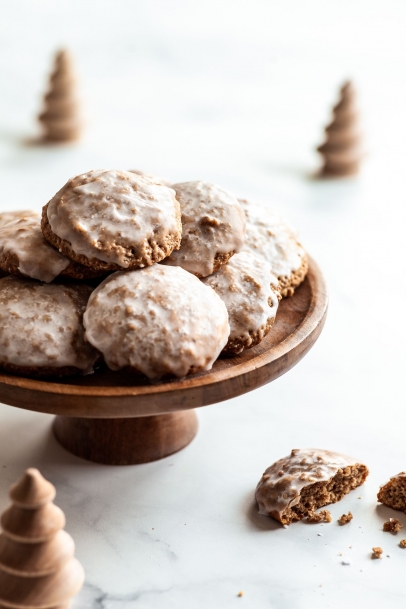Gingerbread
It may come as a surprise that someone growing up in a German household could ever feel deprived of gingerbread during the holidays. Yet as a child, I longed for it—traditional North American gingerbread that is. That’s not to say my home wasn’t filled with baked goods made of ginger, cinnamon, nutmeg and clove (it certainly was). However, the gingerbread confections of my youth looked and tasted a little different to those of my friends.
The word “gingerbread” is a rather broad term which, in medieval England, simply meant preserved ginger. Today, the name is primarily associated with old fashioned cut-out cookies in holiday shapes, cakes and edible architecture adorned with multi-coloured candies. However, the aforementioned are relatively modern. Distinct variations in form and flavour have cropped up across continents since antiquity—gingerbread consumption started long before Hansel and Gretel ventured out into the woods!
Records from Greece and Egypt dating back to 2400 BC appear to contain the very first recipes for gingerbreads with later recipes discovered in 10th century China, where ginger was widely used as medicine. It wasn’t until the Middle Ages that ginger and other spices made their way to Europe, setting the stage for gingerbread’s trajectory towards holiday necessity. During its infancy, recipes typically involved large slabs of heavily spiced dough made with honey, ground nuts and/or breadcrumbs. The dough was placed into carved reliefs featuring nobility or special events then gilded or glazed with icing. While many parts of Europe developed their own unique recipes, most historic gingerbreads were somewhere between a cookie and cake and were consumed year-round for special occasions—this contrasts with more western gingerbread, with a heavy flour and molasses base, appearing almost exclusively during winter festivities. And surprisingly, molasses wasn’t even a common ingredient until the late 18th century, when sugar was considered too cost prohibitive for European settlers in North America.
Most people would agree the holidays need some form of gingerbread, whether that be a cake, pie, flavoured coffee, tea or piped cookies. However, it would feel almost felonious to share a western recipe or contemporary spin-off—the history of gingerbread is too rich to let alone. So, while the child in me loves to eat the buttons off a gingerbread person’s coat, sentimentality veers me toward a familial and historical classic—lebkuchen. Dating back to the 13th century, this beloved German gingerbread still resembles its predecessors—a softer, chewier and deeper spiced cookie that, while somewhat comparable to western varieties, stands on its very own sugar-coated stage.
Instead of molasses and flour, the majority of lebkuchen (pronounced lape-koo-khen) are made with ground nuts, honey or sugar and baked on thin wafers called oblaten. Traditional recipes vary depending on where in Germany they originate—Elisenlebkuchen, developed in Nuremberg during the 1400s, contains a high nut to flour ratio (strictly no more than 10% flour) and happens to be my favourite type. Finely ground almonds and hazelnuts along with candied citrus peel make up the base of these impeccably chewy cookies. Their robust spice profile comes from lebkuchengewürz—a classic spice blend featuring cinnamon, cloves, ginger, cardamom, anise and mace, although variations exist with nutmeg and even coriander. Once baked, these cookies are coated in a delicate sugar glaze, which adds to their sumptuous taste and texture.
My holidays wouldn’t be complete without a tin of lebkuchen to share with family—nothing defines holiday nostalgia better if you ask me.






